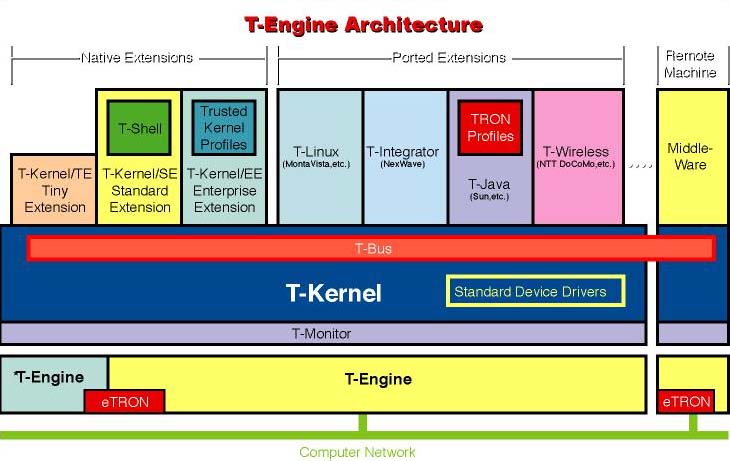

Prof. Ken Sakamura, chairman of the T-Engine Forum and the TRON Project leader, announced on July 9 in a keynote lecture at "6th Embedded Systems Expo & Conference in Tokyo" that the source code for T-Kernel, the standard kernel for the T-Engine open development platform, would be released to the general public in November 2003. In addition, he said that "T-Kernel Standard Extension" would be made available to the general public by March 2004. These will include standard middleware that realize functions not available on some ITRON-specification kernels in the past, such as file management, memory management, and process management. Prof. Sakamura also displayed a highly developed T-Engine Architecture diagram that shows T-Engine's native and ported extensions, plus how T-Engine will relate to remote machines in networks. Although the T-Engine Architecture is still very young, it has reached a remarkably high level of finish in a short period of time.

Another interesting tidbit that Prof. Sakamura threw out during his presentation was that several companies in the YRP Ubiquitous Networking Laboratory have pooled their capital to create a virtual company that is developing an application-specific integrated circuit (ASIC) that will incorporate all of the functions of the T-Engine project's Ubiquitous Communicator excluding the CPU. At present, a T-Engine development board-based Ubiquitous Communicator has been implemented and demonstrated at TRON events, where it has been used to communicate with RFID tags embedded in all sorts of objects. Because it is very bulky and expensive, there is no way that this can come into general use. But a specialized ASIC fitted inside something the size of a cell-phone could come into widespread use, especially if it is put into series production. Prof. Sakamura said this will be developed this year, and that the companies involved are considering licensing their ASIC design to other companies to encourage its use.
For those who are unfamiliar the history of the TRON Project, the T-Engine project is taking the TRON Project in a new direction. In the past, TRON Architecture development was based on the concepts of "open architecture" and "weak standardization." Although they allowed for multiple operating system implementations by various vendors without the payment of royalties, the minor differences in the implementations prevented the construction of a unified development environment and the smooth distribution of the middleware. The µITRON4.0 Specification took the first step away from weak standardization by introducing the concept of "profiles." The T-Engine Specification goes a step further by introducing "strict standardization," which, however, does not include the microprocessor and the system bus. This allows for a unified development environment, and, more importantly, the porting of middleware from one implementation to another through simple recompiling.
There was a T-Engine hardware related announcement in the July. Toshiba Corporation announced that it has developed a T-Engine implementation based on its 64-bit TX4956 RISC microprocessor, which was displayed to the public at the 6th Embedded Systems Expo & Conference in Tokyo. The new T-Engine implementation is officially called "T-Engine/TX4956" (t101), and it will become available in the third quarter of 2003. The T-Engine/TX4956 hardware specification is as follows:
|
|
|
| CPU |
|
| RAM | 128 megabytes |
| Flash memory | 16 megabytes |
| Interfaces |
|
| Expansion bus |
|
| Board size | 120 mm x 75 mm |
| Extended functions |
|
The TX4956 RISC microprocessor is based on the MIPS RISC architecture, which makes the T-Engine/TX4956 the second T-Engine implementation based on this architecture. Like the other T-Engine implementations, T-Engine/TX4956 uses the T-Kernel real-time operating system as its standard operating system. The main selling point of this T-Engine implementation is its extremely low power consumption of only 0.6 watt, which makes it an ideal T-Engine on which to develop high-performance portable applications for ubiquitous computing networks.
A Reuters interview with TRON Project Leader Ken Sakamura (click here) that was later picked up by CNN led to a large number of e-mails being sent to TRON Web in July, plus a lively but uninformed discussion over at Slashdot.org (click here). What's really remarkable about the Reuters story is that it gave a bare outline of the TRON Project. Normally, foreign mainstream news media organizations don't bother writing reports on TRON developments, which is why Linux is more famous than either the Free Software Foundation's GNU project or the TRON Project. Both of these projects began in 1984, seven years prior to the appearance of the first Linux kernel. Judging by the e-mails received by TRON Web, there is strong interest overseas in participating in the TRON Project, because like Linux it is based on openness. People overseas who are interested in TRON should read through the contents of TRON Web, and, if possible, come to the annual TRON show to make contacts with engineers developing TRON plus the leaders of the various organizations endeavoring to propagate TRON.
On July 17, Prof. Sakamura created another stir over the T-Engine's T-Java middleware layer at the Expo Comm Wireless Japan 2003, where he gave a keynote lecture. According to a Japanese-language news article at ZD Net News Japan (click here and look at third caption), he said, "However, since I don't like Unicode, I mentioned it to Sun, and they are making it compatible with Cho Kanji." Cho Kanji is the BTRON3-specification operating system commercialized by Personal Media Corporation, which, of course, is based on TRON Code and the TRON Multilingual Environment. If this is true, then T-Java will be the first foreign developed software platform to be endowed with what is arguable the best multilingual processing system ever developed. It certainly makes engineering sense, since T-Engine will be used as the development board for many handheld information appliances in Japan. These normally have limited memory, and thus there is a desire on the part of engineers to avoid the four-byte encodings that Unicode requires for processing unabridged Chinese character sets.